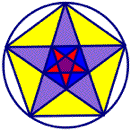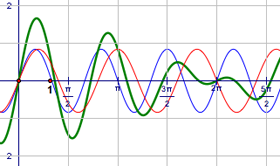|
|
Report from the 2008 NCTM Annual MeetingSalt Lake City, Utah
April 9-12, 2008 The Geometer's Sketchpad featured prominently at the National Council of Teachers of Mathematics 86th Annual Meeting in Salt Lake City. Talk abstracts and User Group details are given below.
Featured Sketchpad Presentations
Constructing Regular Pentagons: Exploring the Geometry of the Golden Ratio with Sketchpad Abstract: Learn how to construct a regular pentagon and see where the golden ratio appears in a regular pentagram. Examine why the golden cut construction results in the value of the golden ratio and how this value is related to Fibonacci numbers and spirals. Abstract: Learn how to construct a regular pentagon and see where the golden ratio appears in a regular pentagram. Examine why the golden cut construction results in the value of the golden ratio and how this value is related to Fibonacci numbers and spirals.
Presenter: Andres Marti, Key Curriculum Press, Emeryville, California
Presentation Materials: Geometry_of_Golden_Ratio.gsp
|
Do the Wave: Trigonometry Comes Alive with Sketchpad Abstract: Trig makes sense and is more fun when students make sinusoids actually wave, combine the waves, and explore real-world applications. See several activities, examine how they improve students' understanding, and receive copies to use with your class. Abstract: Trig makes sense and is more fun when students make sinusoids actually wave, combine the waves, and explore real-world applications. See several activities, examine how they improve students' understanding, and receive copies to use with your class.
Presenter: Scott Steketee, Key Curriculum Press, Oakland, California
Presentation materials: See the talk summary, with downloadable materials.
|
Using Sketchpad Activities to Enrich Textbook Lessons, with Examples from Math TrailblazersAbstract: Explore how dynamic representations help students find patterns and make predictions in both exact and uncertain contexts while laying foundations for multiplicative and algebraic reasoning. Examples will come from Math Trailblazers.
Presenters: Rhea Irvine, Key Curriculum Press, Emeryville, California; and Philip Wagreich, University of Illinois at Chicago, Chicago, Illinois |
Nontypical Investigations in Geometry for 2008Abstract: Can you tile the plane with pentominoes? What is Polya's problem? What are all the Archimedean tilings? What is Pick's formula? If any of these are new to you, come join us as we explore some not-so- typical, cool investigations in geometry.
Presenter: Michael Serra, Key Curriculum Press, San Francisco, California |
Other Sketchpad Presentations
Transform, Iterate, and Create! Iterate a Tiger? Why Not? Megan Did!Abstract: Sketchpad gives students chances to preview major mathematical concepts. We will look at big ideas hidden in the Transform menu, take a bug walk, and design with iterations. Projects that foster the emergence of students' creativity will be shared.
Presenter: Virginia Highstone, York Community High School, Elmhurst, Illinois |
Meaning through Motion: Improving Calculus Understanding through Interactive Computer AnimationsAbstract: Explore interactive computer animations (Sketchpad 4) that greatly improve calculus understanding and literally bring it to life as the study of motion and change. Topics include limits, derivatives, integrals, related rates, volumes, and much more.
Presenter: Audrey Weeks, Calculus In Motion, Burbank, California |
Spinning Around: Using Sketchpad and a Ferris Wheel to Facilitate an Entire Trigonometry UnitAbstract: By modeling the motion of a Ferris wheel in Sketchpad, an entire unit of trigonometry can be faciltated. Students can discover and develop trigonometry concepts from graphing, the unit circle, and even polar coordinates. Sketches will be shared.
Presenter: Kevin Thompson, University High School, Normal, Illinois |
Tour de Pythagoras, Archimedes, and Euclid with The Geometer's Sketchpad, Powerpoint, and a Digital CameraAbstract: We revisit antique (but current) Greek mathematics with modern technology for state-of-the-art teaching and learning of geometry.
Presenters: Armando M. Martinez-Cruz, California State University-Fullerton, Fullerton, California; Paul Sexton, Buena Park High School, Buena Park, California; and Greg Love, Buena Park High School, Buena Park, California |
Using Technology-Based Projects to Foster Geometric Thinking in the Middle GradesAbstract: Join us to discuss classroom-tested projects that engage students using The Geometer's Sketchpad. Topics will include transformations, quadrilaterals, angle relationships, and more. Activities are aligned with the NCTM Standards and include assessments.
Presenters: Jennifer Nickell, Lakota Local Schools, Liberty Township, Ohio; Suzanne Rushton, Harper Miami University, Oxford, Ohio; and Shannon Driskell, University of Dayton, Dayton, Ohio |
On the Shoulders of Technology Your Students Can See FartherAbstract: Let the power of technology bring mathematical insights to your students. The visual capabilities of computers, digital images, and software make your classroom come alive for 21st-century kids.
Presenter: Frank Sobierajski, North Rose-Wolcott Central School District, Wolcott, New York |
Technology-Enhanced Mathematics Instruction: Effects of Visualization on Learning TrigonometryAbstract: Hear details of a research study that found a positive effect for technology use on students' learning of trigonometry. Wholeclass, technology-intensive instruction emphasizing visualization produced superior results over traditional instruction.
Presenter: Jeffrey John Steckroth, Old Dominion University, Norfolk, Virginia Room |
Sketchpad User GroupKey Curriculum Press and KCP Technologies hosted the NCTM Sketchpad User Group. Several Sketchpad users gave fantastic informal presentations.
Keynote PresentationAbstract: Key Curriculum Press and KCP Technologies have, over the past several years, been doing extensive research into how Sketchpad can be used effectively to teach mathematics in younger grades, as well as how it can be even more effective in secondary school math. Out of this research came a collection of hundreds of Sketchpad activities, for grades 3–12, along with a way to search, organize, and assign the activities to students. In the closing presentation, Steve and Daniel introduced the new Sketchpad LessonLink™. Sign up for updates about Sketchpad LessonLink, so you can know when it becomes available.
Presenters: Daniel Scher and Steven Rasmussen, Key Curriculum Press, Emeryville, CA
Presentation Materials: ZoomingDecimals.zip |
Geometry Course ProjectAbstract: My geometry course for preservice teachers uses no textbook, only a list of geometric theorems and terms for which students must create their own entire geometry textbook in GSP. This textbook includes static sketches and definitions, demonstrations of theorems, real world examples of theorems, and proofs. Generally, the project results in an average of 450 pages in GSP! All students report to learning far more in geometry than ever expected and a readiness to teach geometry in high school and middle school.
Presenter: Michael J. Bosse, East Carolina University, Greenville, NC
Presentation Materials: Bosse_NCTM2008.zip |
Sketchpad LessonLinkAbstract: Using Sketchpad in the classroom is even better when you can easily find activities that are directly aligned to your curriculum and assign activties to your students. Bridget shared the soon-to-be-launched Sketchpad LessonLink that will help teachers to easily incorporate Sketchpad activities into classroom planning.
Presenter: Bridget Foster, Key Curriculum Press, Emeryville, CA |
Line Design IntroductionAbstract: An introductory activity to get geometry students (middle and/or high school) excited about beginning and creating a line design project using GSP. This activity is based on a story by Norton Juster. The teacher reads the story and uses this GSP document to illustrate various sections of the story, which includes sketches and animations that correlate to the story.
Presenter: Karen Greenhouse, Key Curriculum Press, Emeryville, CA
Presentation Materials: The_Dot_and_The_Line.gsp |
Physics and SketchpadAbstract: Construction and use of Sketchpad models for physics phenomena allows students to think through basic ideas of mechanics and explore their consequences.
Presenter: Paul J. Karafiol, Walter Payton College Prep H.S., Chicago, IL
Presentation Materials: PJKs_Physics_NCTM2008.zip |
Shadow FunctionsAbstract: Ralph presented a sketch that allows one to investigate the length of the shadow of an object. In the sketch, the height of a light, the position of an object, and the height of an object can be varied, and the length of the shadow formed is shown and plotted in the xy-plane. The shadow is cast either entirely on the ground, or upon the ground and a wall that can also be re-positioned. Important mathematics from Algebra, Geometry, and beyond can be found lurking in these shadows.
Presenter: Ralph Pantozzi, Mount Olive Public Schools, New Jersey
Presentation Sketch: Shadow_Functions_NCTM2008.gsp |
Color Around the PoolAbstract: Frank showed the swimming pool problem with max & mins shown using parametric color, both on the edge of the pool and also in a graph of degrees/radians vs distance. See an online video of this demonstration.
Presenter: Frank Sobierajski, North Rose Wolcott CSD, Cato, NY |
Sketchpad and Some Calculus ActivitiesAbstract: Andy used Sketchpad to verify interesting conjectures about functions and their derivatives.
Presenter: Andy Ventress, Marist High School, Chicago, IL |
|
 Abstract: Learn how to construct a regular pentagon and see where the golden ratio appears in a regular pentagram. Examine why the golden cut construction results in the value of the golden ratio and how this value is related to Fibonacci numbers and spirals.
Abstract: Learn how to construct a regular pentagon and see where the golden ratio appears in a regular pentagram. Examine why the golden cut construction results in the value of the golden ratio and how this value is related to Fibonacci numbers and spirals.  Abstract: Trig makes sense and is more fun when students make sinusoids actually wave, combine the waves, and explore real-world applications. See several activities, examine how they improve students' understanding, and receive copies to use with your class.
Abstract: Trig makes sense and is more fun when students make sinusoids actually wave, combine the waves, and explore real-world applications. See several activities, examine how they improve students' understanding, and receive copies to use with your class.